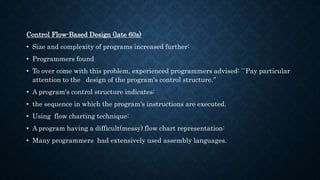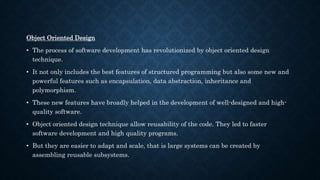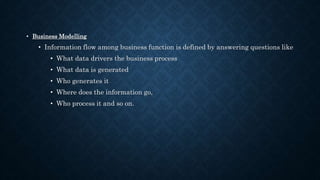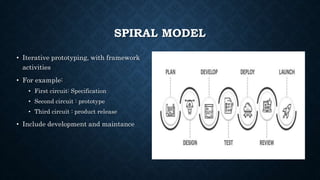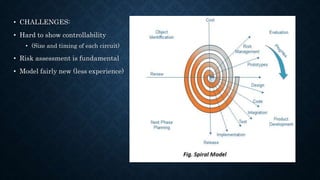Software engineering.pptx
- 2. EMERGENCE OF SOFTWARE ENGINEERING Early Computer Programming (1950s): • Programs were being written in assembly language. • Programs were limited to about a few hundreds of lines of assembly code. • Every programmer developed his own style of writing programs: • according to his intuition (exploratory programming).
- 3. High-Level Language Programming (Early 60s) • High-level languages such as FORTRAN, ALGOL, and COBOL were introduced: • This reduced software development efforts greatly. • Software development style was still exploratory. • Typical program sizes were limited to a few thousands of lines of source code.
- 4. Control Flow-Based Design (late 60s) • Size and complexity of programs increased further: • Programmers found • To over come with this problem, experienced programmers advised: ``Pay particular attention to the design of the program's control structure.'’ • A program's control structure indicates: • the sequence in which the program's instructions are executed. • Using flow charting technique: • A program having a difficult(messy) flow chart representation: • Many programmers had extensively used assembly languages.
- 5. Data-Flow Oriented Design • The computers became more powerful and faster with the introduction of Very Large Scale Integrated Circuits (VLSI), • Therefore, various significant developments like networking and GUIs came into existence. • A new technique known as • data -flow-oriented technique came into existence as the complexity of software could not be dealt with using control flow based design. • In data flow oriented design technique, the flow of data through business functions or processes is represented using Data Flow Diagram (DFD).
- 6. Object Oriented Design • The process of software development has revolutionized by object oriented design technique. • It not only includes the best features of structured programming but also some new and powerful features such as encapsulation, data abstraction, inheritance and polymorphism. • These new features have broadly helped in the development of well-designed and high- quality software. • Object oriented design technique allow reusability of the code. They led to faster software development and high quality programs. • But they are easier to adapt and scale, that is large systems can be created by assembling reusable subsystems.
- 7. EVOLUTIONARY MODEL: successive model • Combination of iterative and incremental model. • Here, we break our into smaller parts. • Prioritize those parts and deliver to customer one by one.
- 8. RAD MODEL • Rapid Application Development • Linear Sequential, Short cycle (60 – 90 days) • RAD Model makes heavy use of reusable software components with an extremely short development cycle.
- 9. • ChALLENGES: • For large projects, sufficient resource are needed for rapid cycle • Strong commitment from developers and customer • Presupposes modular solution • Reusability sometimes implies loss of performance
- 10. • Following phases are • Business Modelling • Data Modelling • Process modelling • Application Modelling • Testing and turnover
- 11. • Business Modelling • Information flow among business function is defined by answering questions like • What data drivers the business process • What data is generated • Who generates it • Where does the information go, • Who process it and so on.
- 12. Data Modelling • Refined into a set of data objects (entities) that are needed to support the business. • The attributes ( character of each entities) are identified and the relation between the data object is defined. Process modelling • Data modelling phase are transformed to achive the data flow necessary to implement a business function. • Processing descriptions are created for adding, modifying, deleting, or retrieving a data object.
- 13. Application Modelling • automated tools are used to facilities construction of the software, • Even they use the 4th GL techniques. Testing and turnover • Many of the programming components have already been tested since RAD emphasis reuse. • This reduces the overall testing time. • But new part must be tested, and all interfaces must be fully exercised.
- 14. SPIRAL MODEL • Iterative prototyping, with framework activities • For example: • First circuit: Specification • Second circuit : prototype • Third circuit : product release • Include development and maintance
- 15. • CHALLENGES: • Hard to show controllability • (Size and timing of each circuit) • Risk assessment is fundamental • Model fairly new (less experience)



